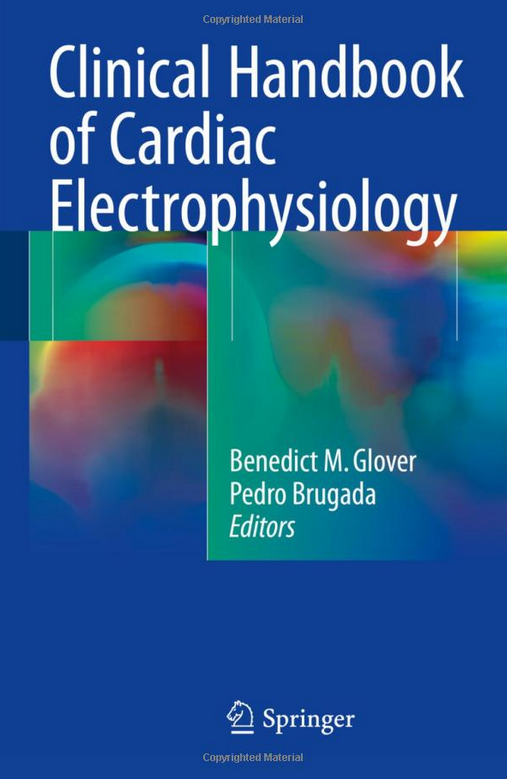Editors: Benedict Glover and Pedro Brugada
 Publisher: Springer International Publishing 2015
Publisher: Springer International Publishing 2015
ISBN: 978-3-319-40816-3
Price: £66.99
Electrophysiology is an exciting, evolving and expanding sub-speciality. One challenge of the field is that it can be relatively inaccessible to those not familiar with its intricacies, who may find the concepts (and intracardiac traces) difficult to master.
A new text “Clinical handbook of cardiac electrophysiology,” edited by Benedict Glover and Pedro Brugada, promises to address the need for a detailed yet accessible transitional text. It is firmly targeted at ‘electrophysiology (EP) beginners,’ be they general cardiologists, junior EP Fellows, or allied health professionals involved in EP cases. It offers a logical and practical approach to cardiac arrhythmia management, covering diagnostic EP, ablation and pharmacology; wisely, the authors have not attempted to address cardiac devices here.
The aim of the handbook is to bridge the chasm between knowledge and understanding of the relevant basic physiology, anatomy and pharmacology and its practical application to patients with arrhythmia. Its small size means that it can be easily taken to the EP lab or clinic, yet it packs in a surprisingly high level of detail.
The first three chapters of the text cover generic and background principles. Chapter 1 is dedicated to a detailed review of the action potential, arrhythmia mechanisms, relevant cardiac anatomy, the electrocardiography (ECG) and the automatic innervation of the heart. The second chapter then moves on to discuss the EP study, diagnostic manoeuvres and catheter ablation. This includes a good level of detail that is helpful to those less familiar with the EP lab and EP procedures, covering topics such as procedural risks, periprocedural sedation/anaesthesia and anticoagulation, EP lab setup, electrogram signals, and ablation techniques. It also describes the steps in undertaking an EP study, including baseline measurements, diagnostic manoeuvres, and trans-septal access. The third chapter then moves on to describe electroanatomic mapping, including both a discussion of general principles, as well as comparing the specific features of three widely-used 3D mapping systems (CARTO, Ensite and Rhythmia).
Having covered this background, the following six chapters each cover a major arrhythmia (atrioventricular nodal reentry tachycardia, accessory pathway conduction, atrial tachycardia, atrial flutter, atrial fibrillation, and ventricular tachycardia [VT]). A standard approach is adopted to the discussion of each arrhythmia, progressing through aetiology, classification and presentation to mechanisms, EP set-up and ablation parameters, and troubleshooting or difficult cases. The final chapter provides a succinct and helpful summary of antiarrhythmic drugs, including some more novel and less familiar agents.
There is much to recommend beyond the logical and concise layout. Important points are summarised at the end of each chapter, and throughout there is liberal use of illustration, be it prosections or 3D CT images that aid understanding of anatomy, fluoroscopy images that give practical pointers in the lab, and the inevitable ECGs and intracardiac electrograms. The emphasis on practical aspects is appreciated – for example, tips on differentiating VT from supraventricular tachycardia (SVT), locating accessory pathways, and so on. Finally, the interested reader is directed towards more in-depth information by the thoughtful inclusion of a number of primary references at the end of each chapter. In contrast, there are few negatives: some readers may find the presence of a few typographic errors irritating, but in truth these do not detract from readability.
Overall this is an excellent introductory text, highly recommended for those with limited experience and keen to gain a deeper understanding of clinical cardiac electrophysiology.
Rohan Wijesurendra
Oxford Centre for Clinical Magnetic Resonance Research (OCMR)
Level 0
John Radcliffe Hospital
Headley Way
Oxford OX3 9DU
